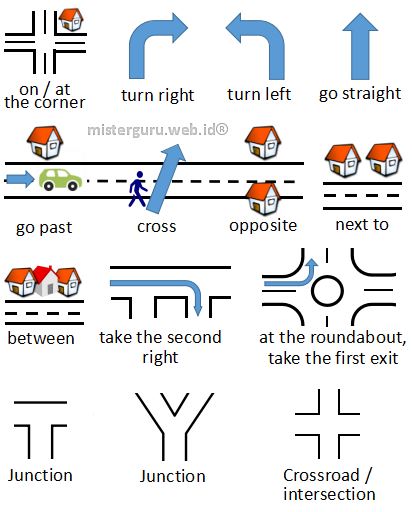What's in this post?
A. How to Ask for Direction
- Where is ..., please?
- How do I get to ...?
- Can you help me, please? I want to get to ....
- Can you tell me where ... is?
- I’m looking for ....
B. How to Give Direction
- Go straight ahead. Take the lift / stairs.
- Turn left / right at the traffic lights.
- Walk straight.
- It’s on your left / right.
- It’s on the second floor.
- It’s upstairs / downstairs.
- Take the first right.
- Take the first exit.
- Take the ... bus and get off at ....
- It's next to ....
- It's opposite ....
C. Useful Expressions with Illustrations
D. Example Dialogues
Dialogue 1Andy stops a passer-by to ask the way to the city museum.
| Andy: | Excuse me, could you tell me where the museum is? |
| Passer-by: | The museum? It’s just over there, next to the park. |
| Andy: | Ah yes, thanks very much. |
| Passer-by: | You're welcome. |
Ann needs to go to an ATM and asks a passer-by.
| Ann: | Excuse me. Could you tell me the way to the nearest ATM? |
| Passer-by: | Well, go straight and turn left at the first junction. Go along the street and you will find a big supermarket. There are ATM booths in front of it. |
| Ann: | And what’s the supermarket called? |
| Passer-by: | Matahari. Shall I write it down for you? |
| Ann: | No, I think I’ve got it. Thanks a lot. |
| Passer-by: | Bye! |
Lidya wants to go to the art gallery but she doesn't know how to get there.
| Lidya: | Excuse me. How could I get to the art gallery? |
| Passer-by: | The art gallery? Get the 11 bus from the corner here, and get off at the Central park. Then turn left into Bright Avenue, and go on until you get to the gallery. It's on your right. |
| Lidya: | Could you write it down for me? I might get lost again otherwise. |
| Passer-by: | Certainly ... [writes it down for Lidya] ... there you are. |
| Lidya: | Thank you for your help. |
| Passer-by: | My pleasure. Enjoy the art gallery! |
| Lidya: | I will. Bye! |
| Passer-by: | Bye! |



